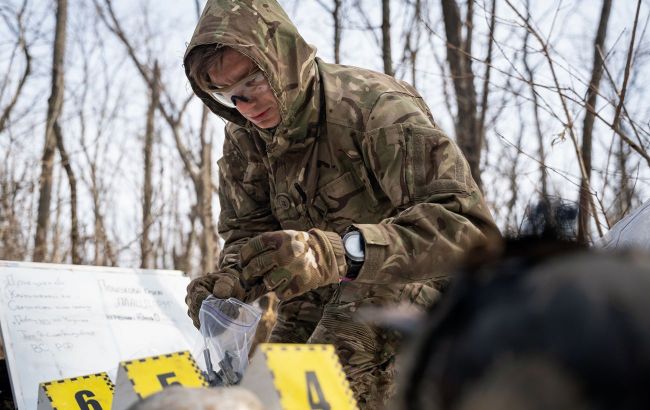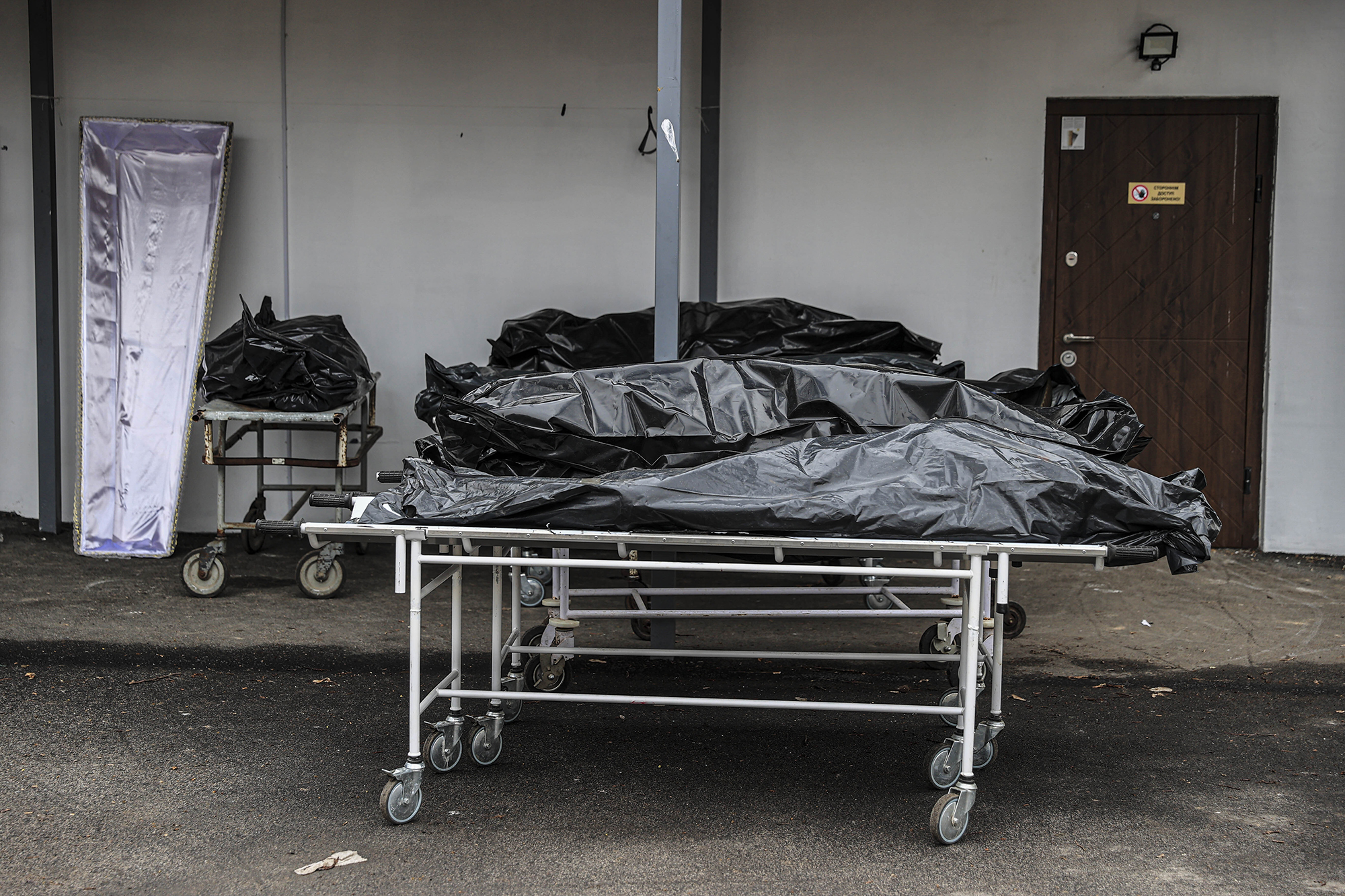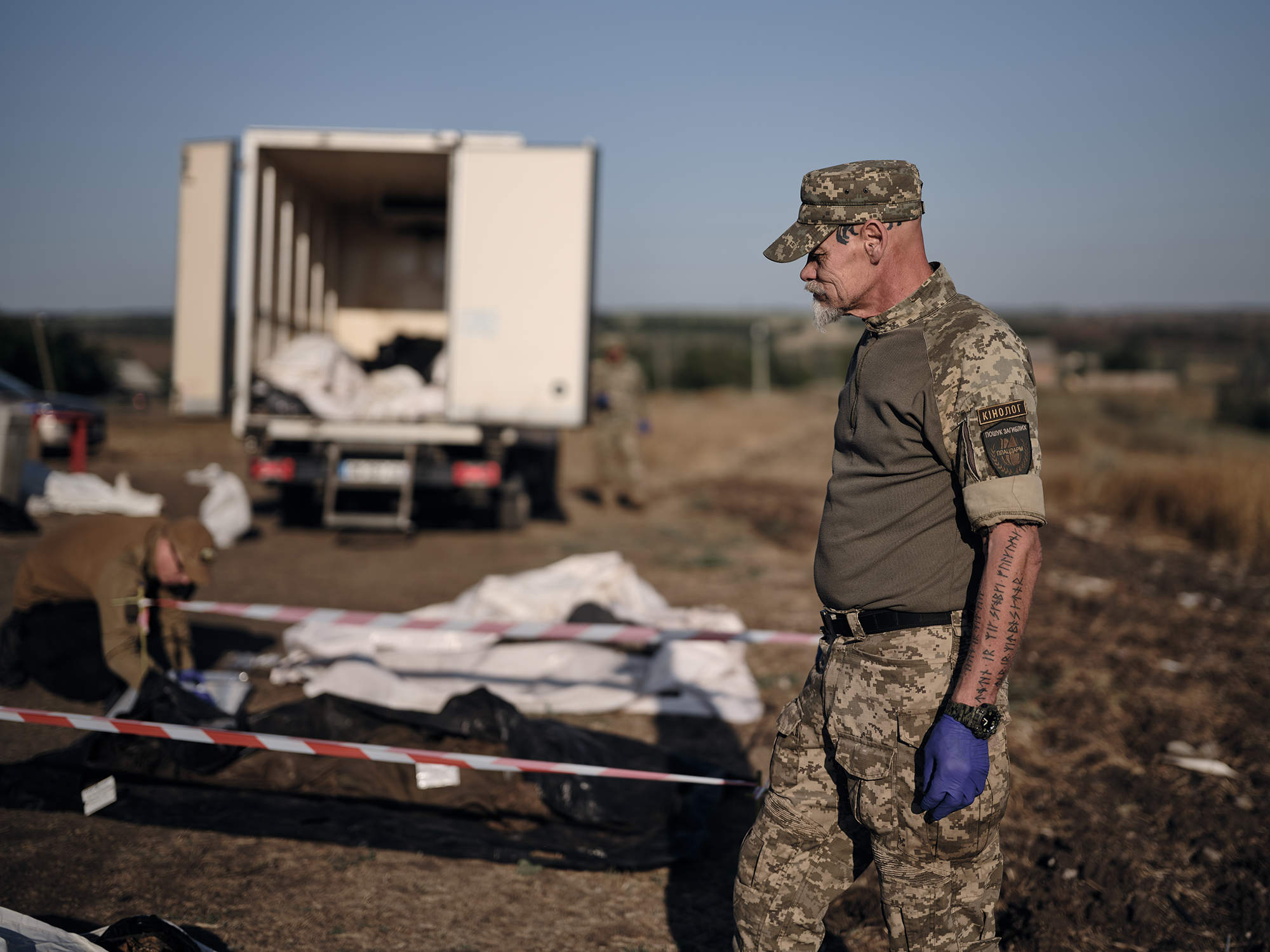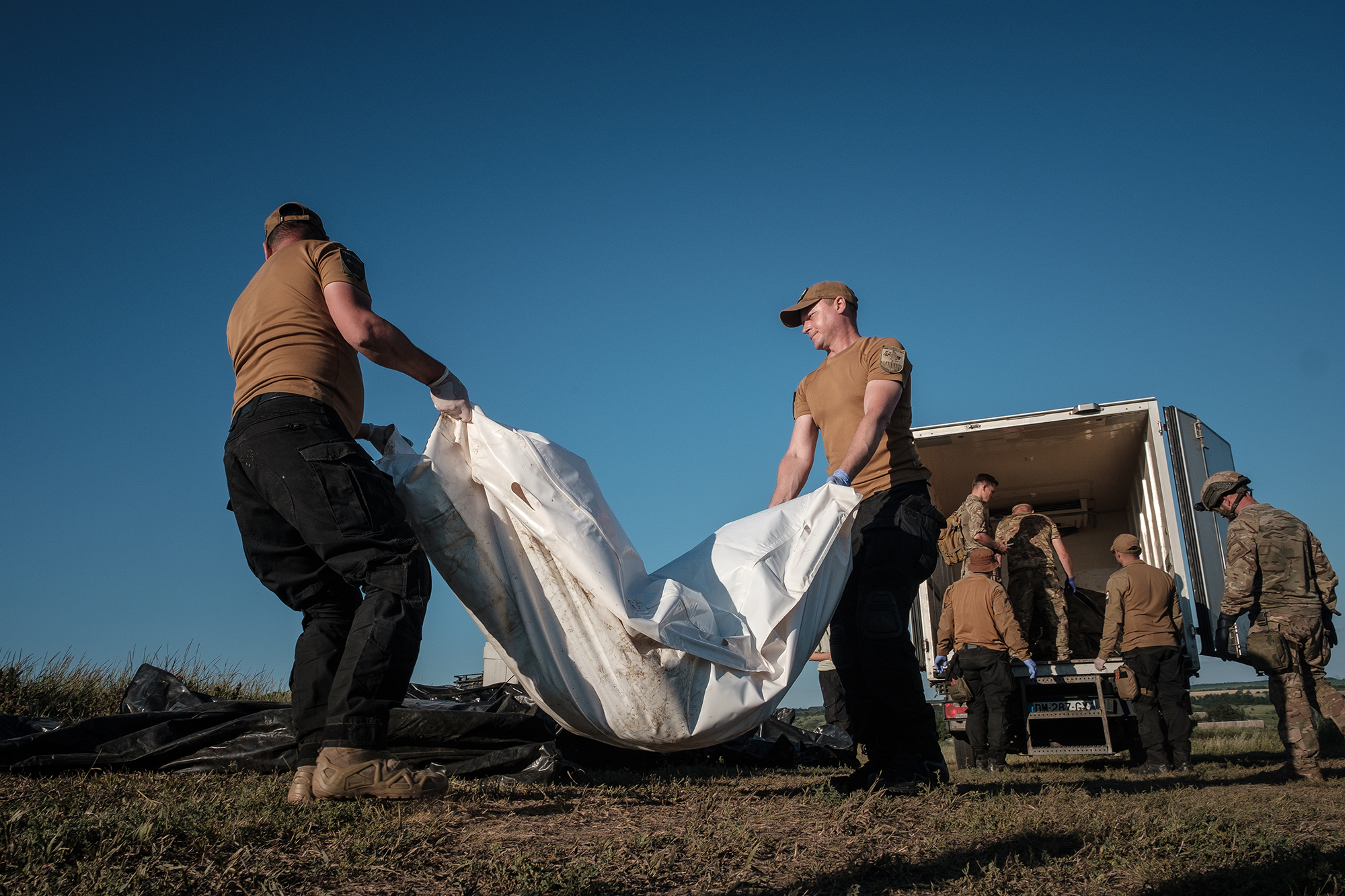On the shield. How Ukraine returns bodies of fallen soldiers and prisoners killed in Russia
 A volunteer takes the body for repatriation (photo: Getty Images)
A volunteer takes the body for repatriation (photo: Getty Images)
The bodies of fallen soldiers and prisoners of war are brought to Ukraine every month. Each of them must be identified and returned to their families. RBC-Ukraine's article explains how the repatriation process works.
Takeaways
- How is the repatriation of the bodies of fallen soldiers from Russia to Ukraine going?
- What do forensic experts who examine the bodies of prisoners of war say?
- How are the dead Ukrainian soldiers identified in Ukraine?
- Does Ukraine have enough resources for identification?
Ukraine and Russia occasionally exchange the bodies of soldiers killed on the battlefield, and much less often civilians. The process of returning bodies to their families is called repatriation. In Ukraine, several agencies are involved in this process, including the Ministry of Internal Affairs and the Ministry of Health. Their institutions examine the bodies delivered for repatriation daily, trying to identify them and hand them over to relatives.
Thousands
In April, another exchange took place between Ukraine and Russia. 909 killed soldiers from different frontlines and Russian morgues were returned to Ukraine. They are transported in large trucks equipped with a special refrigeration system. The same trucks are used to hold bodies that could not be identified.
All 909 bodies are immediately sent to the regional bureaus of forensic medical examination (BME - ed.), where they determine the cause of death. Each one is recorded, filling out hundreds of documents necessary for war crimes investigations.
At the same time, the police are conducting their processes, where relatives come to visit. The disappearance of a serviceman is most often reported in two ways - either by his relatives or by the military unit. Both write statements and wait.
"We keep this area of searching for missing persons under constant control. All investigators are trained and take courses in psychology to communicate with families. There is no problem with how an investigator should behave," Ihor Kalantai, head of the Main Investigation Department of the National Police of Ukraine, tells RBC-Ukraine.
While the police are processing the statements, the bureau is conducting forensic examinations. The forensic experts distinguish two categories of victims whose bodies were delivered for repatriation. These are those who were killed on the frontline and prisoners of war who were killed in Russian special institutions. The first category is the most difficult to deal with - the bodies are taken from the battlefield, where they may have been for some time, says Inna Padei, head of the forensic medical examination department.
"If a body is brought to us from the battlefield, it is mostly in late putrefactive changes. Bodies are fragmented, skeletonized, that is, they are deprived of soft tissue. They are deformed because of the long time they have been exposed to the open environment, and because of blast injuries. Sometimes, when you open the package, you can tell a lot about the body, and sometimes it is impossible to say virtually nothing," the expert tells RBC-Ukraine.
The same dead who are brought from Russian prisons or hospitals have clear signs of critical cachexia. In other words, when a prisoner of war was simply not allowed to eat.
"On such bodies, we also see traces of physical impact, traces of some tools that conduct electric current. The causes of death can be very different. For example, illness, because under abnormal conditions of stay, people get sick and die from it. It can be cancer or infectious diseases," Padei adds.
At this stage, the forensic expert's task is to determine the cause of death and conduct an examination. Difficulties arise at both stages. For example, from time to time, the Russian side is engaged in autopsies of Ukrainian prisoners of war for some reason, which greatly complicates the task of Ukrainian experts.
 Bucha, body exchange (photo: Getty Images)
Bucha, body exchange (photo: Getty Images)
"This means that before the body comes to me for examination or to any of our experts, it has already been cut open and examined. Also, with the selection of biological material for additional research, with numerous sectional cuts. For example, they take skin flaps with wounds for examination," the expert says.
Ukrainian forensic experts do not understand why Russia spends its resources on this. Unless we assume that all this is done for the sake of a banal desire to complicate this procedure for the Ukrainian side. But it's not clear why they take samples for DNA. And it is also very expensive.
The forensic medical examination department, as well as other structures that have had more work since the start of Russia's full-scale invasion of Ukraine, lack personnel. The work is hard and not everyone can handle it, both physically and emotionally. The medical experts try not to let each story of the deceased pass through them, otherwise, they may not be able to bear the work. Padei admits that little shocks her anymore, but there are things that make her very angry.
"During your time here, you've seen so much that you can only be shocked at home by YouTube videos of our people being shot. Defenseless soldiers are either abused or killed. You have seen for yourself what they do to them. We see all of this on our breakout sessions, and we record it all. You are outraged, you discuss it with your colleagues, but this is your job. You see it, but you need to professionally record and document everything," adds Padei.
When the cause of death of a soldier is established, experts identify him. Very often, due to the condition of the body, it is difficult to do this, but it is still necessary to identify it. Research material is taken from 100% of the bodies and taken to the State Forensic Center.
Identification
The institution with the long name, State Scientific Research Forensic Center, is currently focusing its main capacities on identifying dead military personnel. 25 laboratories within the Ministry of Internal Affairs extract DNA profiles. The main office, which also houses the laboratory, is located in Kyiv.
Inside, the premises of the State Scientific Research Forensic Center look like the headquarters of a medical company - there is various equipment everywhere, some of which looks like ovens. Experts in protective suits work behind them. Body fragments of fallen soldiers are brought here to extract DNA profiles.
"10-15 cm of any sample of bone or teeth is enough. Then, in the process of preliminary actions during mechanical processing, we can start conducting molecular genetic research. We do it using certain sets of extractions that break down bone tissue or teeth to the very solution that is already under study, from which DNA is already established," Ruslan Abbasov, Deputy Director of the State Scientific Research Forensic Center, tells RBC-Ukraine.
If the DNA experts manage to obtain blood or a fragment of the deceased's soft tissue, the identification process will be faster. Most often, experts have to deal with bone material. The most difficult thing is to identify a soldier who died from fire.
"If the body is burned, we still need to find biological tissue. DNA is a structure of biological nature, and we understand that it is also denatured, destroyed, and affected not only by the environment, but also by heat. Of course, if it is ashes, it is unlikely that anyone will identify it," Abbasov said.
 Body exchange (photo: Getty Images)
Body exchange (photo: Getty Images)
But still, the most difficult thing for experts is to separate the fragments. Russians often sign the packages when giving bodies for repatriation. But all information is verified without exception. And very often it turns out that a package signed by one name may contain the remains of several people.
"To make sure of this and to identify who these remains belong to, it is necessary to examine virtually all the fragments that are in the same package or different ones, to place them in the Electronic Register of Human Genomic Information. And then, during the study of other remains, we find a match between the remains, and thus it is possible to establish their belonging to one or more persons," the expert adds.
While the DNA profile is being extracted at the State Scientific Research Forensic Center, the same is being done from relatives who have filed a missing person report. Their genomic material is placed in a single register, and then they are notified if the DNA profile matches. The material for the study is taken from the relatives of the missing person, in particular, in specialized centers at the Main Directorates of the National Police.
"We created them to establish communication between citizens and the police. In these centers, they are helped to apply, take a biological sample, conduct an interview, grant a status, explain their rights, responsibilities, and provide consultations. For example, about getting some benefits," says police officer Kalantai.
"When the DNA profiles of the relatives and the deceased match, they are informed and the body is returned. But some soldiers have no relatives. Their disappearance is reported by military unit commanders or friends. Experts do not have the opportunity to take a DNA profile from the other party, but they find a way out.
"Personal belongings are seized - any item that has been in long-term use - a mask, toothbrush, razor, hat, gloves, underwear, personal jewelry, and accessories. Anything that can contain biological material, epithelium, can be used to identify you if a long time has passed. It helps if there are no relatives. There are orphans, or if loved ones have already died," Abbasov adds.
About 25% of the material examined remains without a match. The State Scientific Research Forensic Center cannot say the exact number - it changes every day, the number of deaths is growing, but the number of matches is also growing. Now it is about 30-50 coincidences, but sometimes it reaches a hundred. Experts call this a positive trend. In general, it takes from several hours to a day to extract a DNA profile.
In addition to the DNA profile, there are several other ways to identify a body. First, the deceased can rarely be identified immediately after the body is brought to Ukraine. For example, by tattoos or other special signs. If this is not possible, but the body is in good condition, experts try to identify the person by his or her face, says Leonid Tymchenko, Deputy Minister of Internal Affairs of Ukraine.
"All bodies are usually photographed. If the face allows for photo recognition, we will also recognize it, because we have software that allows for photo recognition. The next stage is working with fingerprints. That is, fingerprints are taken from the body, and with the help of our fingerprint records, we compare them and, if possible, identify the person," Tymchenko says in a comment to RBC-Ukraine.
But still, most of the material ends up in the State Scientific Research Forensic Center. They try to work in such a way that there is no queue, but there are not enough specialists here either. A forensic geneticist is a rather rare specialty that takes a long time to learn. And in today's realities, experts are most shocked by the volume, Abbasov says.
"The volumes are impressive. I already realize that we are all somewhat professionally deformed. We are all really, humanly, a little deformed. To be honest, I wish it were a dream," he admits.
Returning home
In the first 2 years of Russia's full-scale invasion of Ukraine, there were about 30 repatriations. Over the past 6 months, exchanges of the dead have been taking place on average once a month. They are uneven - sometimes the Russian side gives less, sometimes we do. Today, the number of bodies varies from 500 to 1,000 per exchange.
There is no exact information on how many bodies are still in Russia or on the territory controlled by the Russian army. The Ukrainian side is also forced to take dead Russian soldiers from the battlefield to replenish the exchange fund.
Those involved in repatriation, from police officers who take applications to forensic experts, say it took them the longest to get used to the volume. On the other hand, it is critically important to give the body of the deceased to the relatives. For those who have been waiting for a person in the status of "missing" for several years, any change in the situation is already a result.
 Volunteers pick up fallen soldiers (photo: Getty Images)
Volunteers pick up fallen soldiers (photo: Getty Images)
The second thing that took a long time to get used to was the condition of the bodies. Especially when it comes to those brought back from Russian captivity. "Every repatriation is outrageous, and every such event is a very complicated history of our country. We all realize our responsibility. If we are talking about repatriation, we must identify every body. The condition in which the bodies arrive is very outrageous," Tymchenko adds.
In such a sensitive issue as death, it is difficult to be in a stable mental and emotional state. Forensic experts and the police are used to dealing with the dead, but no one expected to be involved in the repatriation of fallen Ukrainian soldiers. But when asked about the general fatigue, many of the speakers did not want to talk.
"Until we win, I will not talk about it. We are working."

